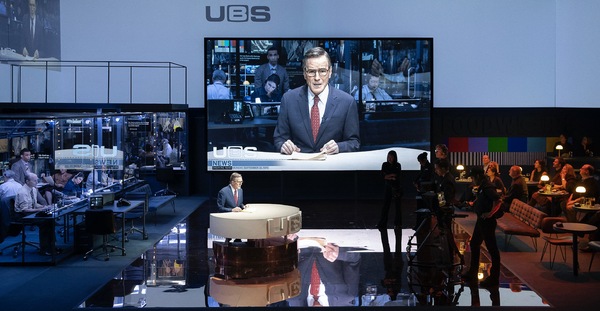Review: 1976 Satire Becomes 2018 Reality in Ivo van Hove and Lee Hall's Striking Adaptation of NETWORK
The audience loudly booed at the end of last Saturday night's preview performance of the new Broadway offering based on Paddy Chayefsky's Oscar-winning screenplay for the 1976 film classic "Network." Seriously, the great majority of viewers at the Belasco Theatre angrily booed what they were seeing onstage, a good many of them yelling out profanity-laced objections. Undoubtedly, playwright Lee Hall and director Ivo van Hove must have been delighted.

(Photo: Jan Verweyveld)
After all, the final image of their production, seen after the cast has taken its bows, was certainly calculated to send playgoers out onto West 44th Street, to paraphrase the film's most famous line, mad as hell and unwilling to take it anymore.
The brilliance of placing a stage adaptation of Chayefsky's story of television news as editorialized entertainment with content controlled by funding corporations is that what was taken as satire over forty years ago can be seen as social commentary in 2018. The outrageous plot twists dramatized by the '76 characters are now resembling contemporary reality... not to mention reality programming. Though the production is a transfer from London's National Theatre, the reaction from Saturday night's audience indicates that this one might prove an especially potent call to action among American audiences during Broadway's evolution into more and more political and social issues oriented theatre that has stirred up recent seasons.
Bryan Cranston gives a nervy, fully textured performances as TV news anchor Howard Beale, one of those distinguished, cool-tempered older white men so beloved by the public decades ago as trustworthy, objective newsmen telling Americans the truth.
But the faltering Network he works for needs a serious ratings boost, so his good buddy, news division president Max Schumacher (Tony Goldwyn), has the unenviable task of giving him two weeks' notice. On the next broadcast, Beale calmly announces that next Monday he will kill himself on the air. ("That'll give the public relations people a week to promote the show. It ought to get a hell of a rating.")
Naturally, he's fired immediately, but Max has managed to allow him one last appearance to go out with dignity. Beale's off-the-cuff expression of dissatisfaction with humanity ("If there's anyone out there who can look around this demented slaughterhouse of a world we live in and tell me man is a noble creature, believe me, that man is full of bullshit.") strikes a chord with an angry, frustrated public that wants more.
By now, programming head Diana Christensen (Tatiana Mastany) has entered the picture, offering Max a chance to juice up the news with graphic footage of massacres, hijackings and assignations that can be supplied for a weekly feature by the terrorist organization committing the acts.
But packaging a show around Beale becomes Diana's priority when it becomes evident that his incensed orations have become a ratings bonanza. She sees him as a latter-day prophet articulating the public rage against the hypocrisies of our times five nights a week.
Van Hove's sharp, vigorous staging fully matches Hall's rapid-fire text, which includes the intricate choreography of putting on a nightly news program performed by members of a 23-member cast.

(Photo: Jan Verweyveld)
Designer Jan Versweyveld's set, primarily the television soundstage, pushes offices and work stations stage left, while on stage right the news-as-entertainment theme is represented by audience members dining in restaurant seating as they watch the play, having selected their menu choices in advance. Video designer Tal Yarden bombards the audience with period television images.
Broadcast news segments are viewed both live and on several large screens, but they also display off-camera moments, bringing home the message that we can never be certain of our privacy in a country where most people carry video cameras with then 24/7. Some scenes are played in hidden corners of the stage, making the screens the only clear view. One scene is played in the street outside the theatre. The evening this reviewer attended the audience was treated to quizzical looks by real-life passers-by while others paid no attention.
It's a overused cliche that a film or play from the past is still just as relevant today, but the excitement generated by Hall and van Hove have is that they've created a contemporary lens with which to view Chayefsky's exceptional work, giving it greater impact for today.
The film's famous catch-phrase was, "I'm mad as hall and I'm not going to take it anymore." The catch-phrase for this adaptation might as well be, "Why didn't we see this coming?"


